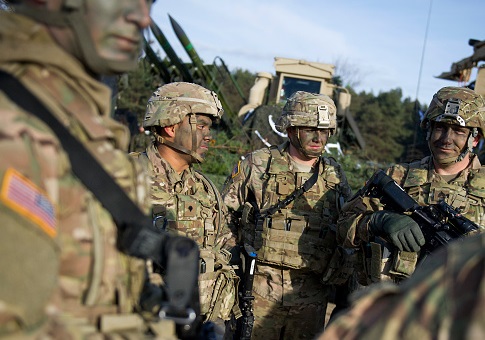NATO is set to approve the creation of two new commands to strengthen alliance weaknesses in a potential conflict with Russia, according to allied officials.
NATO defense ministers will review a new command structure—meant to improve allied logistics and protect supply lines—at their quarterly meeting next month, the Wall Street Journal reported Tuesday.
The recommendations include one new command to manage NATO logistics, which would focus on moving people and materiel more quickly, and one new command for the Atlantic and Arctic Oceans, which would focus on protecting sea lanes, critical for supplying Europe, from submarine threats.
The potential command changes come amid rising tensions between NATO and Russia. Alliance leaders have warned that member countries must be able to move quicker to effectively deter and counter Russian forces.
"The alliance has to move as quick or quicker than Russian Federation forces for our deterrent to be effective," Lt. Gen. Ben Hodges, the top Army commander in Europe, said earlier this month. "Speed is what will give our civilian leaders options other than a liberation campaign."
NATO spokeswoman Oana Lungescu said the command structure review is meant to focus on military mobility so the alliance can "deploy forces quickly across the alliance." She added that NATO members are "adapting national legislation to allow military equipment to transit faster across borders and are working on improving national infrastructure."
The potential changes are partly in response to calls from some Eastern European alliance members to better prepare for crises.
"We have to revise how fast we make decisions and prepare better," Lithuanian President Dalia Grybauskaitė told the Journal.
The new commands' headquarters would be at the same level as NATO's Joint Forces Commands, located in Brunssom, Netherlands and Naples, Italy.
Plans for a new NATO command structure review come as the United States places more military resources in Europe to deter Russian aggression. This week alone, the 1st Air Cavalry Brigade arrived in Belgium with 89 helicopters that will go to Germany, Latvia, Romania, and Poland. Congress is evaluating whether to permanently station a tank brigade along with other units in Europe permanently.
NATO is reviewing a new logistics command partly because of the difficulties NATO faces with moving personnel and equipment across borders. Often a country has to give approval ahead of time for certain weapons and equipment to cross its borders, and many European roads and bridges cannot handle the weight of an American battle tank, the U.S. Army's five-axle tank transport trailers, or heavy air-defense batteries, further complicating movements.
At sea, Russia has recently invested in newer submarines with more advanced technology, triggering calls for a new Arctic and Atlantic command.
